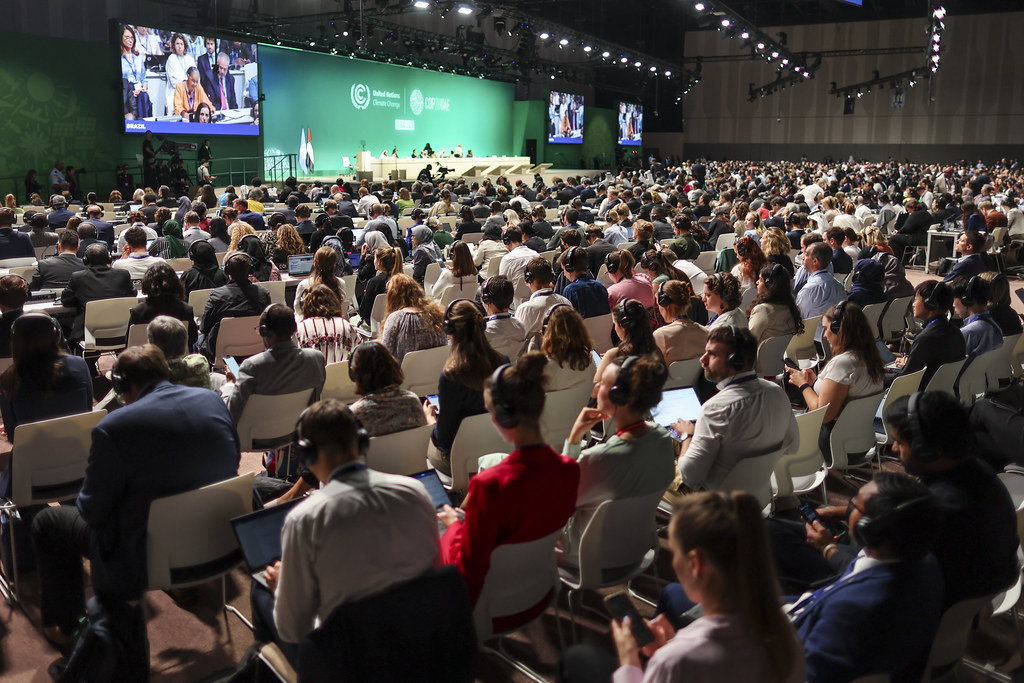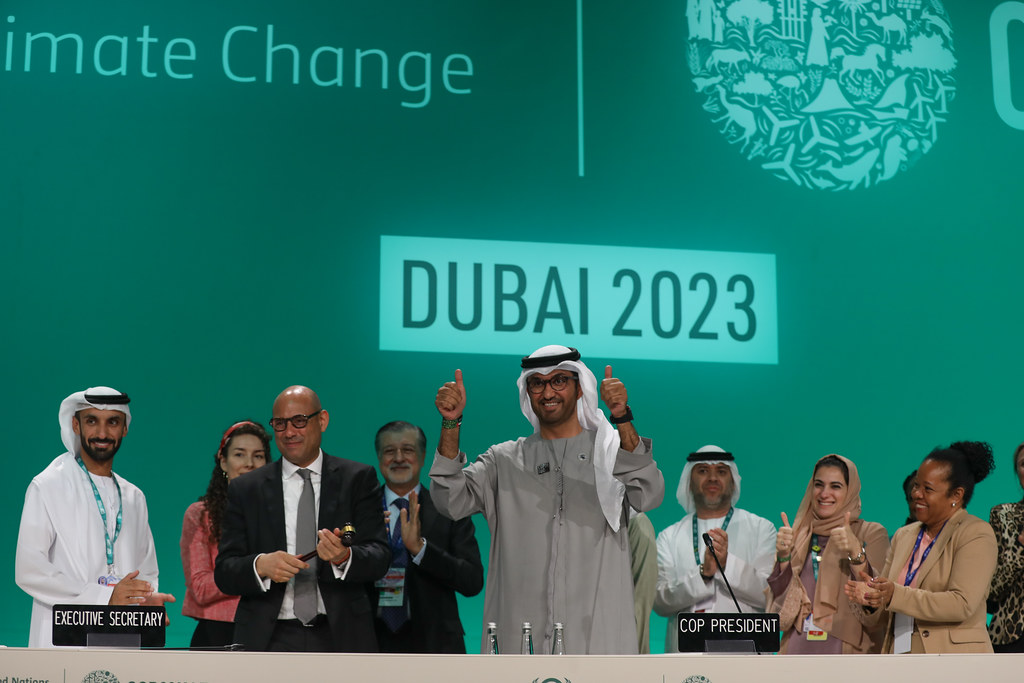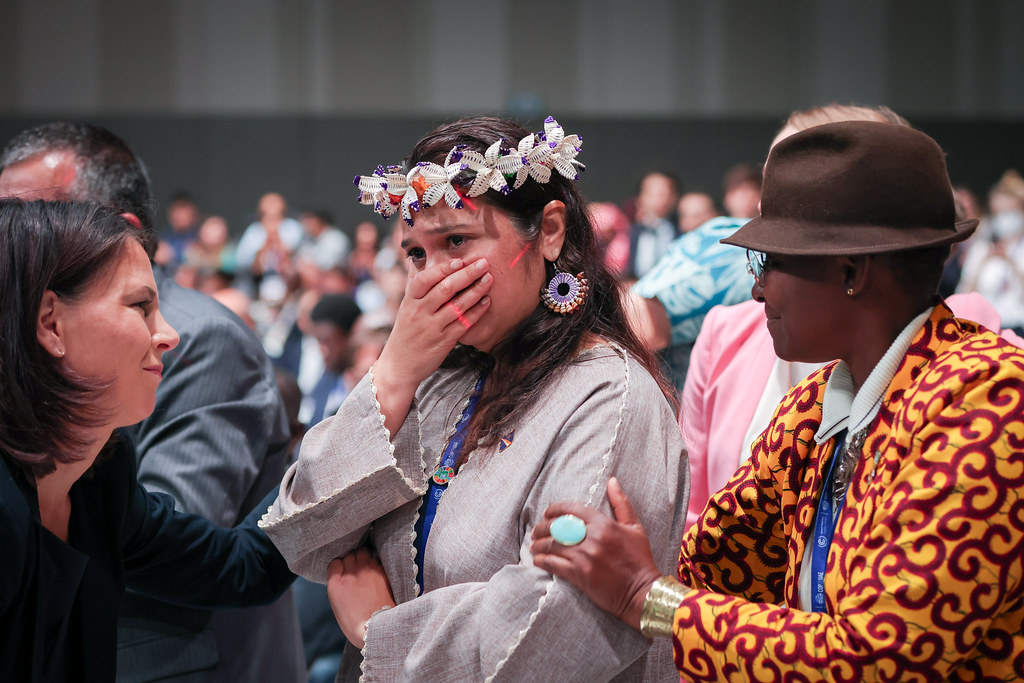Expo City Dubai, United Arab Emirates —(Map)
The world’s countries have reached a new climate agreement. For the first time, the deal clearly calls on countries to move away from using fossil fuels to create energy. But many people say the agreement doesn’t go far enough to protect the planet from global warming.
Climate Crisis
Since people first began burning coal to run factories, the world’s temperature has gone up by about 1.2 degrees Celsius (C)**. This increase has led to serious long-term changes in weather patterns that affect all life on Earth.
The world is getting hotter, mainly because humans are burning “fossil fuels” like coal, oil, and natural gas to make energy. These fuels give off pollution called “greenhouse gases” or “carbon emissions”, which make the climate emergency worse.
The effects of climate change can already be seen: melting ice in Antarctica and the Arctic, higher temperatures, heat waves, droughts, wildfires, record rains, and more strong hurricanes.
Scientists say the world must take strong action before 2030, and limit global warming to 1.5ºC to avoid the worst effects of the climate crisis.

(Source: Mahmoud Khaled/COP28, via UNFCCC, Flickr.com.)
The agreement was reached at COP28* – the United Nations climate meeting in Dubai, United Arab Emirates (UAE). People representing nearly 200 countries took part in the meeting. The goal was to reach agreements that will help slow global warming.
One of the big questions about COP28 was whether countries would agree to stop producing fossil fuels (called a “phase-out”), or would simply agree to produce less (a “phase-down”). The UAE is a major oil producer. And the president of this year’s meeting, Sultan Al Jaber, leads the UAE’s largest oil company.
Over 100 countries, including the United States and the European Union, were pushing for a phase-out. But countries like Saudi Arabia, China, and India fought against this idea. These countries either depend heavily on fossil fuels, or on the money they make by selling them.

(Source: UNFCCC, via Flickr.com.)
Because of this disagreement, the final deal doesn’t mention a phase-out or a phase-down. Instead, it calls for “transitioning [slowly changing] away from fossil fuels”. That’s a huge disappointment to many people who had hoped for a stronger position. But it’s also the first time a COP meeting has mentioned moving away from fossil fuels.
The new agreement isn’t a law, but it does guide countries on the actions they should take to tackle the climate crisis. Countries now need to create their own plans for how they will cut greenhouse gas emissions over the next 12 years. The new deal strongly suggests that clean, renewable energy sources are a better choice than fossil fuels.
The deal calls for a huge increase in clean energy. Around 130 countries have promised to produce three times as much renewable energy by 2030.
😕
This image has not been loaded because of your cookie choices. To view the content, you can accept 'Non-necessary' cookies.
This year’s COP28 meeting brought promises to reduce the amount of methane gas that gets released. Most of these efforts focus on methane released from oil and gas production. Above, natural gases (including methane) being burned off as oil is drilled.
This year’s COP28 meeting also brought important promises to reduce the amount of methane gas that gets released. Methane is a greenhouse gas that’s far more powerful than carbon dioxide, but doesn’t last as long in the atmosphere.
Most of these efforts focus on methane released from oil and gas production. But growing meat for food is responsible for about 32% of methane emissions. So far, this source of methane hasn’t gotten much attention.
The effects of the climate crisis are rapidly growing more serious. The new agreement comes as scientists report that 2023 is expected to be the hottest year ever recorded.

(Source: Christopher Edralin/COP28, via UNFCCC, Flickr.com.)
Scientists say that to keep global warming below 1.5º Celsius (2.7º Fahrenheit), countries need to cut emissions by 43% by 2030. Currently, the world is only on track to cut emissions by about 10% by that time.
Representatives from small island countries are especially upset that the COP28 deal did not call for a phase-out of fossil fuels. These countries say the current deal fails to tackle the climate crisis quickly enough. They believe this puts their nations at risk from rising sea levels.
* COP stands for “Conference of the Parties”, which basically means “Meeting of the countries that signed the agreement”. In this case, the agreement is the 1992 United Nations Framework Convention on Climate Change. This was the 28th meeting since the agreement was first signed.
** Climate change temperatures are measured against the time when humans started burning coal for power. This article talks about climate change using Celsius (C). Talking about climate change in Celsius is more common and it makes the changes easier to see and remember.
If you want to think about the temperature changes in Fahrenheit( F), you can use these figures: 1.2ºC = 2.16ºF, 1.5°C = 2.7°F, 2°C = 3.6°F.
😕
This map has not been loaded because of your cookie choices. To view the content, you can accept 'Non-necessary' cookies.
